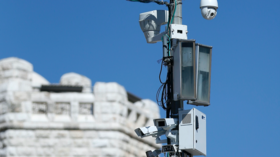Big Brother is watching you (from afar): US spies seek long-range facial recognition capabilities
US intelligence agencies are looking to enhance their facial recognition capabilities with technology that can identify people from hundreds of meters away, potentially transforming drones into biometrically accurate spy cameras.
The Office of the Director of National Intelligence (ODNI) wants any and all information that could help current biometric surveillance tech overcome the inaccuracy that comes with distance, according to a request for information posted by the Intelligence Advanced Research Projects Agency (IARPA) – the intelligence community’s even-more-secretive-than-usual research arm.
The agency is hungry for anything that could be “useful in planning a program focused on advancing the state-of-the-art biometric recognition and identification at altitude and range (BRIAR)” – from “biometric research datasets” captured using drones, to datasets captured from long distances or unusual angles, to research on fusing multiple types of biometric identification to overcome faults in one mode or another.
Also on rt.com Get out of my face! Facial recognition technology could enslave mankind like never beforeIARPA appears particularly interested in long-distance facial recognition that factors in other biometric identifiers such as gait, allowing for accurate matching even when a subject’s face is partially obscured so long as their walk matched an existing profile – a major boon to a technology that can be thwarted by sudden movement or “atmospheric turbulence,” especially at a distance. The information request laments that “there remains challenges in diverse face detection, verification and identification when dealing with low-resolution or noisy imagery” or images shot from aerial view, thanks to “a lack of authorized and sharable research data.”
“Further research in the area of biometric recognition and identification at altitude and range may support protection of critical infrastructure and transportation facilities, military force protection, and border security,” IARPA reassures any contractor who might be worried about high-powered surveillance turned against innocent citizens, though contractors are (one hopes) aware that surplus military technology frequently ends up in the hands of domestic police forces, and the legal definition of the “border” includes any area within 100 miles of the US’ “external boundaries” – leaving two thirds of Americans living in what the ACLU and civil liberties groups have termed “Constitution-free zones.”
Also on rt.com Amazon ‘smart’ doorbell company partnered with 400+ police departments to surveil your neighborhoodIARPA has previously deployed machine learning to assist facial-recognition surveillance, augmenting captured images with three-dimensional and contextual data using a program called JANUS. The agency also hopes to train algorithms to track its prey across multiple surveillance cameras, potentially allowing it to pursue a target through an entire city.
Like this story? Share it with a friend!













